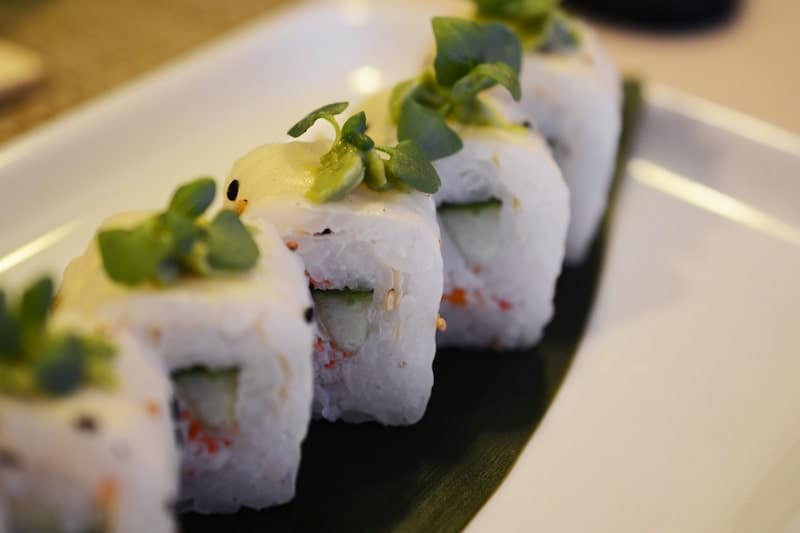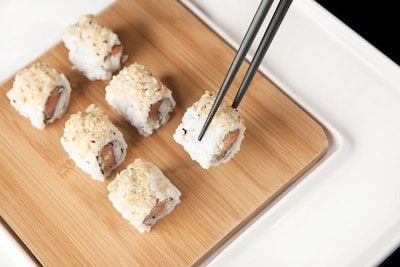Sushi Rice vs. Sticky Rice (Similarities and Differences Explained)
Many rice and sushi lovers tend to interchangeably use sushi rice and sticky rice.
Even though they are similar, some key differences exist. Depending on what you prepare, this can make a massive difference in the end result.
But what exactly are the similarities and differences when it comes to sushi rice vs. sticky rice? Keep on reading to find out the answer.
| Sushi Rice | Sticky Rice | |
| Stickiness | Sticky | Sticky |
| Type of Grain | Short grain | Short, medium, and long grain |
| Color | White and brown | White, brown, yellow, purple, black |
| Sweet | Yes | Yes |
| Salt Levels | High | Low |
| Types Of Dishes | Mainly different types of sushi | Sushi, steamed lotus leaf wraps, pearl meatballs, mango sticky rice, peanut sticky rice, stuffed lotus root, sweets, dumplings, and stuffing for ducks |
What Is Sushi Rice?
If you prepare sushi rolls in the US, the primary ingredient will likely be the sushi rice found in grocery stores.
As this rice has a higher water content, sushi rolls benefit significantly from its stickiness.
Japanese short-grain white rice is the ideal and most common type of rice for preparing sushi rolls, especially in the traditional method. However, many varieties of rice may be utilized.
This is because sushi rice is not a specific type of rice but rather a way of cooking the rice.
Short-grain Japanese white rice is typically flavored with sugar, salt, and vinegar when it’s cooked. After being chilled and refrigerated, this mixture is most commonly used to make sushi.
A bowl of well-balanced sushi rice is not just sticky but also sweet, sour, and salty. Consequently, it doesn’t overpower the flavors of the other components.
Originally, sushi rolls did not include sugar. The sushi rice was only used to keep the fish fresh.
The idea of putting vinegar in sushi rice didn’t originate until the middle of the 17th century. It wasn’t until the Edo era, almost 200 years ago, that sushi as we know it today was first created.
Fishermen used to sell sushi rice along with fresh fish, which marked the beginning of sushi rolls as we know it.
In addition, the amylose content of sushi rice is higher than that of sweet rice. As a result, it retains its stickiness even after cooling but is also quite pliable.
What Is Sticky Rice?
Besides Thailand and Laos, sticky rice is farmed mostly throughout Southeast and East Asia.
As a bonus, sticky or sweet rice requires little to no water care. Hence, it may be found in both upland and lowland paddies.
In addition, the starch in sweet rice is what makes it sticky. Due to its high amylopectin content, sticky rice is extremely sticky when boiled.
The antioxidants, vitamins, and minerals in sticky rice make it an excellent food choice.
Though sticky rice is extensively used in Asian cuisine, it is most commonly used in Chinese meals such as sweets, dumplings, and stuffing for duck.
The rice can also be used for risotto (fried) and be steamed or boiled.
Long-grain sticky rice is used in savory dishes in Chinese cuisine, whereas short-grain sticky rice is used in sweet dishes.
Some of the most typical sticky rice dishes are steamed lotus leaf wraps, pearl meatballs, mango sticky rice, peanut sticky rice, and stuffed lotus root.
Due to its high starch content, sticky rice can come in various colors and has a chalk-like appearance. For example, hulled sticky rice is typically white, but the unhulled variety might be purple or black.
The colorful types of rice are more expensive since they are more challenging to find and are usually used in preparing high-end sweets.
What Are the Similarities Between Sushi Rice and Sticky Rice?
The most significant similarity and why most people confuse sticky rice, and sushi rice is that they’re both sticky.
As mentioned, sticky rice is sticky because of its high starch levels.
Sushi rice is also naturally sticky. Since primarily Japanese short-grain rice is used, the way sushi rice is made adds to its stickiness.
The second reason these two types of rice are confused is that you can use them both for sushi.
Even though there is long and short-grain sticky rice, the short-grain variety can be used for sushi.
The lines between sushi and sticky rice get even more blurred when you put the sticky rice through the sushi rice preparation process.
The third similarity is that both types are on the sweet side.
Sticky rice is naturally sweet and is therefore used in many Asian desserts. While making sushi rice, sugar is often added to the mixture.
However, even though the sugar levels are higher than most rice types, the sweetness isn’t as prominent as in sticky rice due to the other ingredients added during the process.
What Are the Differences Between Sushi Rice and Sticky Rice?
The most significant difference between sushi rice vs. sticky rice is that sticky rice is an actual type of rice, while sushi rice refers to the way the rice is prepared.
The second difference is that you can use only short-grain rice for sushi rice.
The most common type is Japanese white short-grain rice. However, sticky rice has both long- and short-grain variants used in many dishes.
The third big difference is the type of meals the rice is used in.
While both types can be used for sushi, sticky rice can also be used for a slew of different meals.
Some examples are steamed lotus leaf wraps, pearl meatballs, mango sticky rice, peanut sticky rice, stuffed lotus root, sweets, dumplings, and stuffing for ducks.
Finally, sticky rice is often considered a healthier variant than sushi rice.
The reason is sushi rice has added sugar and high salt levels. Therefore, sticky rice, predominantly brown rice, is recommended as an alternative for sushi rice.
In Summary
If the sushi rice vs. sticky rice dilemma gives you a headache, consider what dish you want to make.
There’s no doubt that sushi and sticky rice are two distinct types of rice that should be utilized for various reasons in the kitchen.
For example, sticky rice is the most acceptable option for making mocha and Japanese rice cakes.
In contrast, mix vinegar, salt, and sugar with Japanese short-grain to make sushi rolls.







